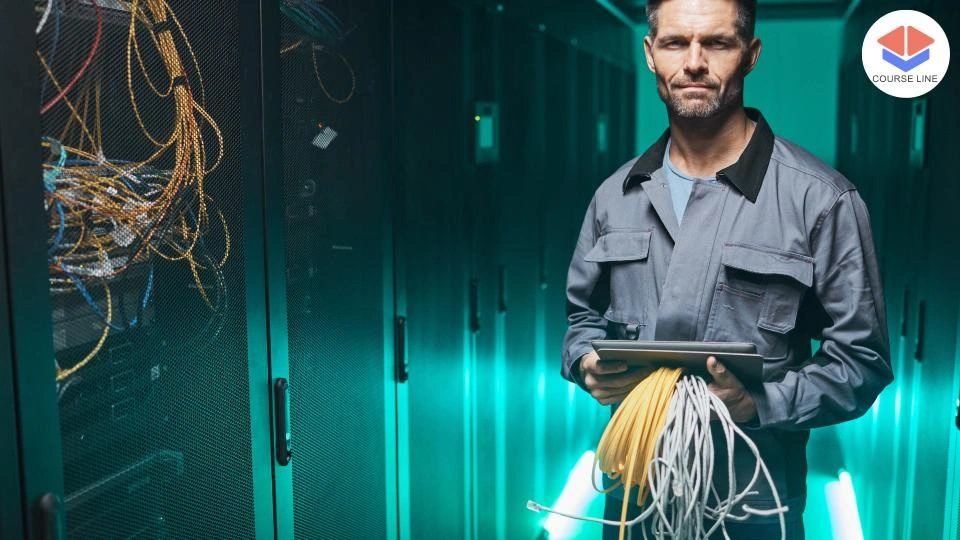Course Features
Price
Study Method
Online | Self-paced
Course Format
Reading Material - PDF, article
Duration
7 hours, 25 minutes
Qualification
No formal qualification
Certificate
At completion
Additional info
Coming soon
- Share
Overview
The IT Technician Level 1 course is designed to give learners a comprehensive foundation in the core principles and practices of information technology. Whether you're completely new to the field or aiming to build your technical confidence, this course covers all essential areas required to begin a successful career in IT support and systems maintenance.
The course begins with an introduction to the IT industry and the typical responsibilities of an IT technician. Learners explore computer hardware components such as motherboards, processors, RAM, and storage devices, gaining hands-on knowledge of assembling and configuring basic desktop systems. Input/output devices, safety handling, and hardware troubleshooting are also covered to ensure students can confidently work with various systems.
Software fundamentals are a key focus of this programme. Students learn about the differences between operating systems and application software, along with how to install, configure, and troubleshoot popular platforms like Windows, macOS, and Linux. By mastering these skills, learners will be prepared to solve common issues and assist users with day-to-day software challenges.
Networking basics introduce the essential concepts of connecting systems, including the roles of routers, switches, modems, and the distinctions between wired and wireless networks. Practical training on setting up a basic home or small office network provides learners with real-world experience in configuring and troubleshooting network environments.
In addition to technical proficiency, the course emphasizes computer maintenance, diagnostic procedures, and data security. Lessons on malware prevention, antivirus setup, firewalls, and backup practices prepare students to protect systems from threats. Best practices in user permissions and safe data handling are also addressed, aligning with industry cybersecurity expectations.
The course also features dedicated training in customer service and communication, ensuring that learners can effectively assist users, document issues, and manage support tickets with professionalism. Training on remote assistance tools and managing difficult clients helps round out the soft skills needed for front-line IT roles.
To enhance technical capability, learners will become familiar with common IT tools, diagnostic software, and basic scripting. Introduction to virtual machines and command-line utilities ensures learners are ready to support both physical and virtual IT environments.
The final section of the course is devoted to career development and progression. Learners receive guidance on preparing for industry certifications such as CompTIA A+ and Cisco CCNA, building a strong resume, developing interview skills, and mapping out further education opportunities in networking, cybersecurity, or systems administration.
This course is ideal for complete beginners, school leavers, career changers, or anyone looking to enter the IT industry. It’s also suitable for individuals who want to build a solid foundation before pursuing more advanced IT certifications or technical diplomas.
Who is this course for?
The IT Technician Level 1 course is designed to give learners a comprehensive foundation in the core principles and practices of information technology. Whether you're completely new to the field or aiming to build your technical confidence, this course covers all essential areas required to begin a successful career in IT support and systems maintenance.
The course begins with an introduction to the IT industry and the typical responsibilities of an IT technician. Learners explore computer hardware components such as motherboards, processors, RAM, and storage devices, gaining hands-on knowledge of assembling and configuring basic desktop systems. Input/output devices, safety handling, and hardware troubleshooting are also covered to ensure students can confidently work with various systems.
Software fundamentals are a key focus of this programme. Students learn about the differences between operating systems and application software, along with how to install, configure, and troubleshoot popular platforms like Windows, macOS, and Linux. By mastering these skills, learners will be prepared to solve common issues and assist users with day-to-day software challenges.
Networking basics introduce the essential concepts of connecting systems, including the roles of routers, switches, modems, and the distinctions between wired and wireless networks. Practical training on setting up a basic home or small office network provides learners with real-world experience in configuring and troubleshooting network environments.
In addition to technical proficiency, the course emphasizes computer maintenance, diagnostic procedures, and data security. Lessons on malware prevention, antivirus setup, firewalls, and backup practices prepare students to protect systems from threats. Best practices in user permissions and safe data handling are also addressed, aligning with industry cybersecurity expectations.
The course also features dedicated training in customer service and communication, ensuring that learners can effectively assist users, document issues, and manage support tickets with professionalism. Training on remote assistance tools and managing difficult clients helps round out the soft skills needed for front-line IT roles.
To enhance technical capability, learners will become familiar with common IT tools, diagnostic software, and basic scripting. Introduction to virtual machines and command-line utilities ensures learners are ready to support both physical and virtual IT environments.
The final section of the course is devoted to career development and progression. Learners receive guidance on preparing for industry certifications such as CompTIA A+ and Cisco CCNA, building a strong resume, developing interview skills, and mapping out further education opportunities in networking, cybersecurity, or systems administration.
This course is ideal for complete beginners, school leavers, career changers, or anyone looking to enter the IT industry. It’s also suitable for individuals who want to build a solid foundation before pursuing more advanced IT certifications or technical diplomas.
Requirements
The IT Technician Level 1 course is designed to give learners a comprehensive foundation in the core principles and practices of information technology. Whether you're completely new to the field or aiming to build your technical confidence, this course covers all essential areas required to begin a successful career in IT support and systems maintenance.
The course begins with an introduction to the IT industry and the typical responsibilities of an IT technician. Learners explore computer hardware components such as motherboards, processors, RAM, and storage devices, gaining hands-on knowledge of assembling and configuring basic desktop systems. Input/output devices, safety handling, and hardware troubleshooting are also covered to ensure students can confidently work with various systems.
Software fundamentals are a key focus of this programme. Students learn about the differences between operating systems and application software, along with how to install, configure, and troubleshoot popular platforms like Windows, macOS, and Linux. By mastering these skills, learners will be prepared to solve common issues and assist users with day-to-day software challenges.
Networking basics introduce the essential concepts of connecting systems, including the roles of routers, switches, modems, and the distinctions between wired and wireless networks. Practical training on setting up a basic home or small office network provides learners with real-world experience in configuring and troubleshooting network environments.
In addition to technical proficiency, the course emphasizes computer maintenance, diagnostic procedures, and data security. Lessons on malware prevention, antivirus setup, firewalls, and backup practices prepare students to protect systems from threats. Best practices in user permissions and safe data handling are also addressed, aligning with industry cybersecurity expectations.
The course also features dedicated training in customer service and communication, ensuring that learners can effectively assist users, document issues, and manage support tickets with professionalism. Training on remote assistance tools and managing difficult clients helps round out the soft skills needed for front-line IT roles.
To enhance technical capability, learners will become familiar with common IT tools, diagnostic software, and basic scripting. Introduction to virtual machines and command-line utilities ensures learners are ready to support both physical and virtual IT environments.
The final section of the course is devoted to career development and progression. Learners receive guidance on preparing for industry certifications such as CompTIA A+ and Cisco CCNA, building a strong resume, developing interview skills, and mapping out further education opportunities in networking, cybersecurity, or systems administration.
This course is ideal for complete beginners, school leavers, career changers, or anyone looking to enter the IT industry. It’s also suitable for individuals who want to build a solid foundation before pursuing more advanced IT certifications or technical diplomas.
Career path
The IT Technician Level 1 course is designed to give learners a comprehensive foundation in the core principles and practices of information technology. Whether you're completely new to the field or aiming to build your technical confidence, this course covers all essential areas required to begin a successful career in IT support and systems maintenance.
The course begins with an introduction to the IT industry and the typical responsibilities of an IT technician. Learners explore computer hardware components such as motherboards, processors, RAM, and storage devices, gaining hands-on knowledge of assembling and configuring basic desktop systems. Input/output devices, safety handling, and hardware troubleshooting are also covered to ensure students can confidently work with various systems.
Software fundamentals are a key focus of this programme. Students learn about the differences between operating systems and application software, along with how to install, configure, and troubleshoot popular platforms like Windows, macOS, and Linux. By mastering these skills, learners will be prepared to solve common issues and assist users with day-to-day software challenges.
Networking basics introduce the essential concepts of connecting systems, including the roles of routers, switches, modems, and the distinctions between wired and wireless networks. Practical training on setting up a basic home or small office network provides learners with real-world experience in configuring and troubleshooting network environments.
In addition to technical proficiency, the course emphasizes computer maintenance, diagnostic procedures, and data security. Lessons on malware prevention, antivirus setup, firewalls, and backup practices prepare students to protect systems from threats. Best practices in user permissions and safe data handling are also addressed, aligning with industry cybersecurity expectations.
The course also features dedicated training in customer service and communication, ensuring that learners can effectively assist users, document issues, and manage support tickets with professionalism. Training on remote assistance tools and managing difficult clients helps round out the soft skills needed for front-line IT roles.
To enhance technical capability, learners will become familiar with common IT tools, diagnostic software, and basic scripting. Introduction to virtual machines and command-line utilities ensures learners are ready to support both physical and virtual IT environments.
The final section of the course is devoted to career development and progression. Learners receive guidance on preparing for industry certifications such as CompTIA A+ and Cisco CCNA, building a strong resume, developing interview skills, and mapping out further education opportunities in networking, cybersecurity, or systems administration.
This course is ideal for complete beginners, school leavers, career changers, or anyone looking to enter the IT industry. It’s also suitable for individuals who want to build a solid foundation before pursuing more advanced IT certifications or technical diplomas.
-
- Overview of the IT Industry 00:10:00
- Key Roles and Responsibilities of an IT Technician 00:10:00
- Introduction to Computer Components (Motherboard, CPU, RAM, etc.) 00:10:00
- Storage Devices: HDDs, SSDs, and External Drives 00:10:00
- Input and Output Devices (Keyboards, Mice, Printers, Monitors) 00:10:00
-
- Types of Software: Operating Systems vs. Applications 00:10:00
- Installing and Configuring Operating Systems (Windows, macOS, Linux) 00:10:00
- Software Installation and Removal 00:10:00
- Basic Software Troubleshooting Techniques 00:10:00
- Introduction to Computer Networks 00:10:00
- Network Devices and Their Functions (Routers, Switches, Modems) 00:10:00
- Wired vs. Wireless Networks 00:10:00
- Setting Up a Basic Home Network 00:10:00
- Common Network Troubleshooting Techniques 00:10:00
- Introduction to IT Security 00:10:00
- Types of Malware and How to Prevent Them (Viruses, Trojans, etc.) 00:10:00
- Firewall and Antivirus Basics 00:10:00
- Understanding User Permissions and Access Control 00:10:00
- Basic Data Backup Procedures and Best Practices 00:10:00
- Overview of Essential IT Tools (Multimeter, Screwdrivers, Crimpers) 00:10:00
- Software Tools for IT Technicians (Diagnostics, Remote Access, etc.) 00:10:00
- Setting Up and Using Virtual Machines 00:10:00
- Using Command Line and Scripting for Basic Tasks 00:10:00
- Exam of IT Technician Level 1 00:50:00

No Reviews found for this course.
Is this certificate recognized?
Yes, our premium certificate and transcript are widely recognized and accepted by embassies worldwide, particularly by the UK embassy. This adds credibility to your qualification and enhances its value for professional and academic purposes.
I am a beginner. Is this course suitable for me?
Yes, this course is designed for learners of all levels, including beginners. The content is structured to provide step-by-step guidance, ensuring that even those with no prior experience can follow along and gain valuable knowledge.
I am a professional. Is this course suitable for me?
Yes, professionals will also benefit from this course. It covers advanced concepts, practical applications, and industry insights that can help enhance existing skills and knowledge. Whether you are looking to refine your expertise or expand your qualifications, this course provides valuable learning.
Does this course have an expiry date?
No, you have lifetime access to the course. Once enrolled, you can revisit the materials at any time as long as the course remains available. Additionally, we regularly update our content to ensure it stays relevant and up to date.
How do I claim my free certificate?
I trust you’re in good health. Your free certificate can be located in the Achievement section. The option to purchase a CPD certificate is available but entirely optional, and you may choose to skip it. Please be aware that it’s crucial to click the “Complete” button to ensure the certificate is generated, as this process is entirely automated.
Does this course have assessments and assignments?
Yes, the course includes both assessments and assignments. Your final marks will be determined by a combination of 20% from assignments and 80% from assessments. These evaluations are designed to test your understanding and ensure you have grasped the key concepts effectively.
Is this course accredited?
We are a recognized course provider with CPD, UKRLP, and AOHT membership. The logos of these accreditation bodies will be featured on your premium certificate and transcript, ensuring credibility and professional recognition.
Will I receive a certificate upon completion?
Yes, you will receive a free digital certificate automatically once you complete the course. If you would like a premium CPD-accredited certificate, either in digital or physical format, you can upgrade for a small fee.
Course Features
Price
Study Method
Online | Self-paced
Course Format
Reading Material - PDF, article
Duration
7 hours, 25 minutes
Qualification
No formal qualification
Certificate
At completion
Additional info
Coming soon
- Share
GRE Advanced Quant: Data Interpretation & Quant Comparison
Course Line237$1,005.66Original price was: $1,005.66.$30.77Current price is: $30.77.Dressmaking Level 3 Advanced Diploma
Course Line239$1,005.66Original price was: $1,005.66.$30.77Current price is: $30.77.Family Law: Key Principles and Practical Applications
Course Line241$1,005.66Original price was: $1,005.66.$30.77Current price is: $30.77.





